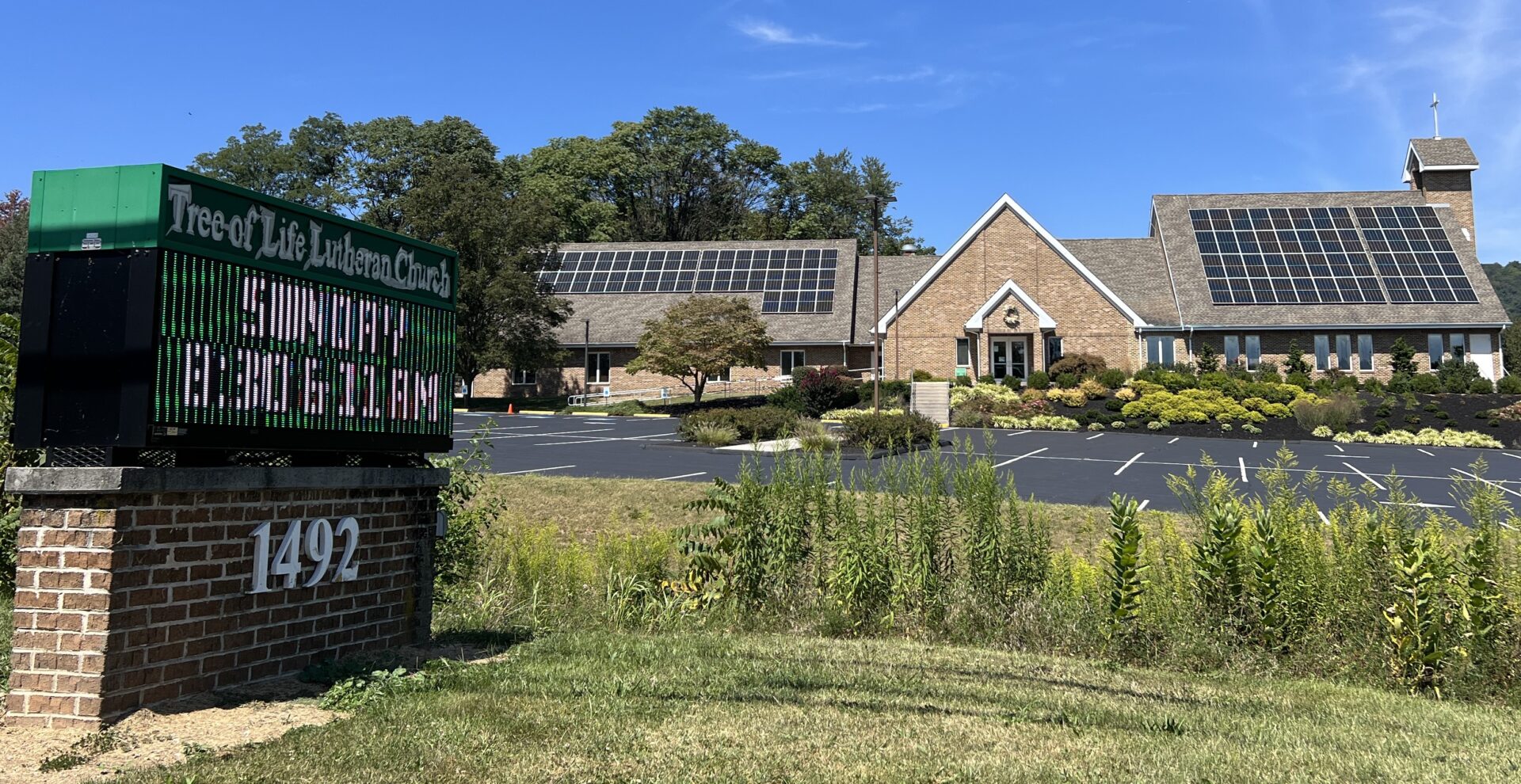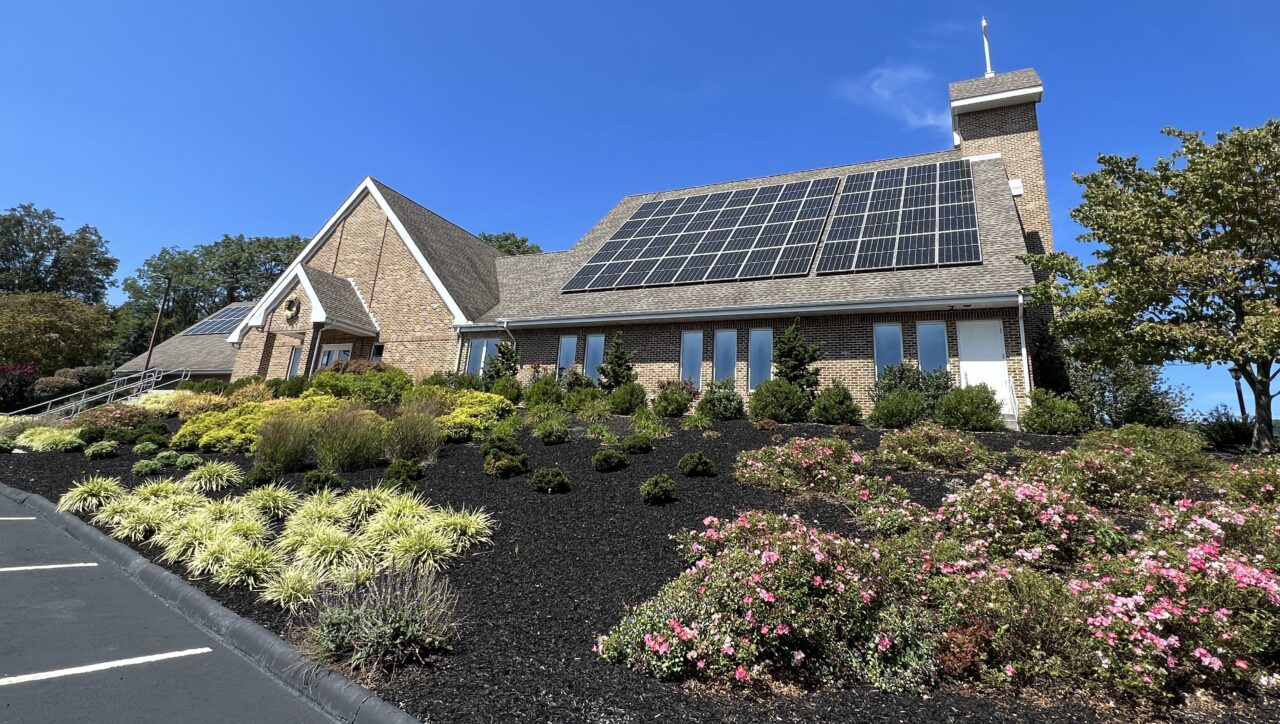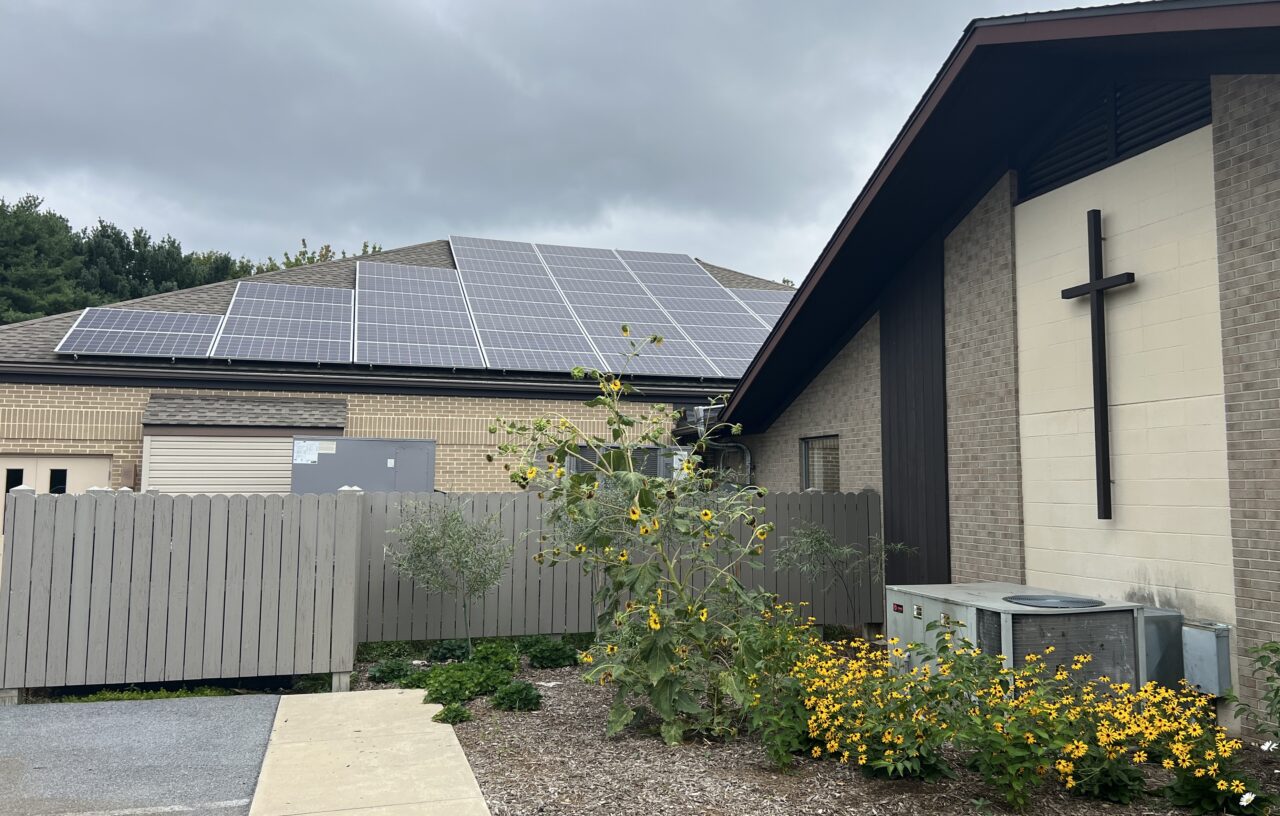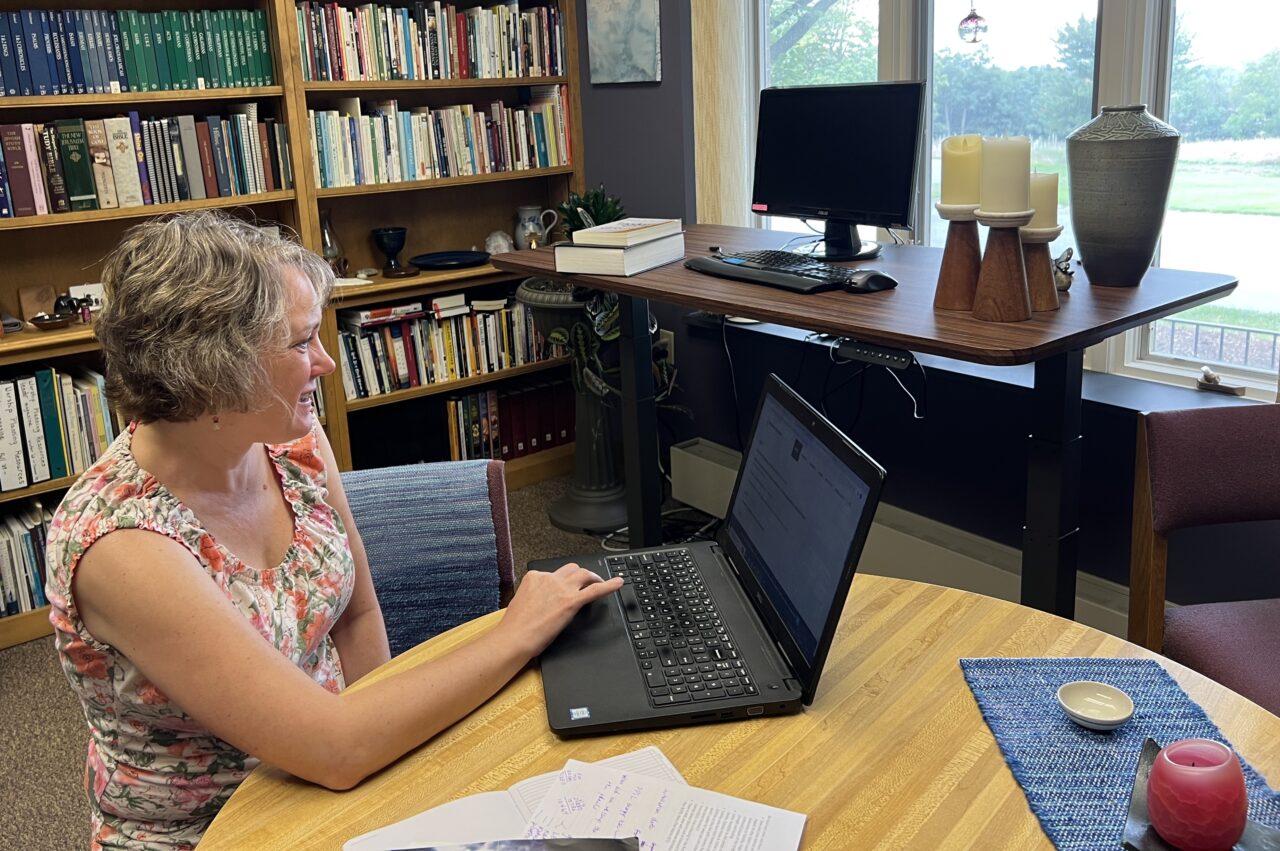
Tree of Life Lutheran Church, on Linglestown Road in Harrisburg, says its solar panels are projected to save the church $10,000 a year in electricity costs.
Karen Hendricks / For Climate Solutions


Tree of Life Lutheran Church, on Linglestown Road in Harrisburg, says its solar panels are projected to save the church $10,000 a year in electricity costs.
Karen Hendricks / For Climate Solutions

Karen Hendricks / For Climate Solutions
Tree of Life Lutheran Church, on Linglestown Road in Harrisburg, says its solar panels are projected to save the church $10,000 a year in electricity costs.
 This story was produced as part of Climate Solutions, a collaboration focused on community engagement and solutions-based reporting to help Central Pennsylvania move toward climate literacy, resilience and adaptation. StateImpact Pennsylvania convened the collaboration; WITF is a Climate Solutions partner.
This story was produced as part of Climate Solutions, a collaboration focused on community engagement and solutions-based reporting to help Central Pennsylvania move toward climate literacy, resilience and adaptation. StateImpact Pennsylvania convened the collaboration; WITF is a Climate Solutions partner.
Between 10,000 and 12,000 vehicles pass Harrisburg’s Tree of Life Lutheran Church every day. The location, along the growing Linglestown Road corridor, helps the congregation make a highly-visible statement about their faith.
Beyond the neon message board, there’s another message, shining atop the church roof, in the shadow of the steeple: a roof full of solar panels.
“People are seeing the solar panels as an example of a green solution and a positive expression of what it means to be the church,” said the Rev. Richard Geib, Tree of Life’s pastor of 36 years.
The sun provides nearly all the power needed for the congregation’s three buildings.
It’s a scene playing out in other Pennsylvania communities, as houses of worship say solar lowers their carbon footprint as part of their responses to climate change and “creation care” called for in the Bible.
In Lancaster County, solar panels atop Akron Mennonite Church offset their electric bill — not only for their worship space, but for a large child care center within the church. And St. Andrew’s Episcopal Church in Lewisburg, Union County installed solar panels in August with a goal of becoming carbon neutral.
All three churches hope to inspire their communities—individuals, businesses and nonprofits—to switch to solar, as an alternative to fossil fuels.
The churches could be considered early adopters. Across Pennsylvania, solar power drives only half of one percent of the state’s electricity. The state ranks 26th in installed solar capacity through the second quarter of 2023, according to the Solar Energy Industries Association. It projects the state will rise to 20th over the next five years.
Tree of Life, Growing Green
Tree of Life’s 900-member congregation talked about going solar for a long time, but “it always seemed too financially inaccessible,” Geib said.
Instead, their Growing Green Task Force followed other “Creation Care” guidelines suggested by the national Lutheran church to its 8,900 congregations of 3.3 million people. Tinted sanctuary windows and LED lightbulbs were energy savers. Environmentally-friendly landscaping incorporated plants for pollinators.
“But the project that loomed out there was solar,” Geib said.

Karen Hendricks / For Climate Solutions
Tree of Life Lutheran Church in Harrisburg says its solar panels provide almost all the power it needs for its three buildings.
In 2022, a couple in the congregation made an offer: If the church council approved the transition to solar power, they would pay the bill. Panels were installed in early 2023, with a price tag of $130,000.
Projections point to an annual savings of $10,000 in electricity costs—around 90% of the church’s electricity needs.
The initial hope was to achieve carbon neutrality, but the church’s post-Covid use –and therefore, energy use – has increased, especially by community groups like the Boy Scouts. Still, Geib said this foot traffic increases community awareness of their solar panels.
Money that the church would have spent on electric bills is going into a fund to maintain and eventually replace the solar panels after their expected lifetime of 30 years.
The project united and energized the congregation, Geib said, without politicization or division.
“Definitely early on when the money wasn’t there, there were those who questioned the stewardship of doing this,” he said. “If there are climate change deniers in the congregation, they haven’t verbalized it. Everyone is convinced about the cost savings—it wasn’t seen as a political issue.”
Geib has even quoted scripture in reference to solar transition and climate change.
“I’ve tried to say to the congregation this is a simple thing: Whether you’re on board or not on board with climate change, it still remains that this earth is the lord’s and the fullness therein [Psalm 24:1]. Wherever you fall on the politics of climate change, the theology is the same. It’s a positive expression of our faith.”

Karen Hendricks / For Climate Solutions
A view of solar panels atop the childcare center at Akron Mennonite Church in Lancaster County.
Solar Power: Preventing Disaster
Taking action in response to climate change has been a priority among the 110-member Akron Mennonite Church for at least 10 years. The congregation, said Pastor Rachel Nolt, has “a broad world view” thanks in great part to its involvement in the Mennonite Central Committee, a nonprofit known for its relief work around the globe. MCC’s American headquarters are in Akron.
“We as a church are quick to respond to disasters,” Nolt said, noting that climate change influences events like wildfires and hurricanes. “And if we are responding to disasters, why wouldn’t we try to prevent disasters?”
When they decided to install solar panels, church offerings raised $117,500. But they didn’t receive a state grant for an additional $130,000.
“When the grant fell through, we thought we might not do it,” Nolt recalled. “But supporters said, ‘Why would that stop us from doing what is right?’ It’s part of our understanding that, as people of faith, as Christians, it is our calling, our duty and expectation that we are to care for the earth.”

Karen Hendricks / For Climate Solutions
Pastor Rachel Nolt of Akron Mennonite Church in Lancaster County reviews solar savings on her computer. The church didn’t get a grant to help install solar panels, but it put up as many as it could through the congregation’s support.
So the church installed as many panels as it could afford, and solar power launched in September 2020. The solar panels are saving the congregation—including its child care center — nearly $1,000 a month. While the church isn’t putting solar savings in a specific fund, it’s tracking them in a spreadsheet so it can determine when it’s paid for itself.
Software helps the church monitor solar activity in real time. It even estimates “CO2 avoidance” — the amount of carbon dioxide not emitted into the atmosphere thanks to solar use. On a day in late August, that figure was 33 pounds at mid-day.
Raising the Roof
At Lewisburg’s St. Andrew’s Episcopal Church, overhead was “cutting out our mission,” said Maggie Chappen, congregational council leader.
The church, which has fewer than 100 members, donates to a local homeless shelter, an after-school center and runs a monthly diaper bank.
“The more our electric bill eats up our available funding, the less of those things we can do,” Chappen said. “So if we can reduce those fixed expenses, the more we can do. If we are going to keep our building, we have to keep the lights on.”
Solar power was on their mind, in part because the Episcopal Church, nationally, set a goal for its 6,300 congregations to be carbon neutral by 2030.
St. Andrew’s encountered challenges, but now shares their experience in an effort to help other churches.
First, St. Andrew’s consulted the state website, DEP’s Solar Energy Resource Hub. There, churches can grasp the differences between privately-owned solar and power purchase agreements (PPA) which operate like a small lease with the solar provider.
Next, by checking with their utility, they determined the best option was private ownership of their solar installation. This means the church would own its solar panels. Chappen said two factors were in their favor: Solar costs have dropped in the past 10 years, and the federal Inflation Reduction Act increased churches’ access to tax rebates.
“The only way to receive rebates for a private installation was through tax rebates,” Chappen said, “but as a nonprofit, we had no access at first. That was a big change about a year ago with the passage of the Inflation Reduction Act (IRA), meaning we’d be eligible for a 30% rebate.”
Additionally, St. Andrew’s could seek grants, opening a “double stream of reimbursement,” Chappen said.
Still, there was one big snag: the initial upfront cost. Like Tree of Life’s scenario, a donor stepped forward with a $30,000 gift.
St. Andrew’s solar array, which was supposed to cost $65,000, was installed this summer. But the final price tag ballooned to $80,000 after one more twist in the plotline. Because solar panels are installed atop roofs, the skyward-facing surface needs to be in excellent condition. St. Andrew’s needed a partial roof replacement to support the panels.
All told, the church estimates it will save $4,000 annually in energy bills.
“We realize one tiny church in the center of rural Pennsylvania isn’t going to solve the climate crisis,” Chappen said, “but if we can help 100 other churches….”
Her words trail off, as she imagines a ripple effect. Like Tree of Life, St. Andrew’s is along a highly-trafficked roadway — Route 15.
Katie Ruth, executive director of the nonprofit Pennsylvania Interfaith Power & Light (PA IPL), cites two creation stories in Genesis. One, she says, motivates people to be caretakers of the earth, while another calls on them to be in peacemaking relationships with others.
One word has become a sticking point. In Genesis, the word “dominion” has been misinterpreted by some over the years, says Pastor Richard Geib at Harrisburg’s Tree of Life Lutheran Church.
“God’s command to us at the time of creation is to have dominion over the earth,” Geib says. “And dominion can be perceived as ruthless kingship or generous stewardship—and I think stewardship is the direction the church goes in.”
“Religion,” Chappen said, “should give us a sense of hope.”
Working for a Greater Good
Christian churches aren’t the only ones seeking climate solutions. Nearly 20 faith denominations from Buddhists to Quakers have issued statements setting courses of climate action for their believers.
One nonprofit organization works to bind believers of all faiths together. Pennsylvania Interfaith Power & Light is an affiliate of IPL National, which sees climate change as “a moral issue—one that demands a response from people of faith.”
And Pennsylvania, in particular, is poised for climate-friendly seeds of faith to grow, according to Katie Ruth, PA IPL’s executive director.
“Pennsylvania is one of the most religious states in the Northeast,” she said. “There are about 15,000 congregations in PA. And between 50 to 60 percent of Pennsylvanians participate in some form of house of worship regularly.”
Based in Lancaster, PA IPL works across Pennsylvania to educate and empower people of faith to play leadership roles in climate change issues – including helping congregations figure out how to go solar. The theme of the nonprofit’s November annual conference is “No Faith in Fossil Fuels.”
“Churches are massive holders of land and resources—some of the biggest land-holding or asset-holding groups in the world,” Ruth said. “And so the way we steward these lands is incredibly important and influential on the public buy-in that needs to happen, for the transition from fossil fuels to happen.”

Karen Hendricks / For Climate Solutions
Katie Ruth is executive director of the nonprofit Pennsylvania Interfaith Power & Light.
Ruth said finding solutions to climate challenges is a way of showing care.
“We know the impacts of climate change and climate pollution disproportionately impacts the elderly, the disadvantaged, people of color, and on and on,” she said. “So in living in right relationship with each other and recognizing that we are given this land as a gift, it is not ours to exploit. It’s our faith that compels us into action.”
About 100 Pennsylvania churches are members of PA IPL, although the organization’s messages reach many other congregations. Ruth described participation as “diverse, from very progressive to more conservative” churches.
Although the organization works hard to “build a table where everyone is welcome,” she acknowledged that many conservative-leaning churches opt out of climate change-related conversations.
PA IPL is surveying churches to determine how many are using solar. Ruth said she knows of at least 15, and said at least a dozen churches have called PA IPL for solar guidance over the past year.
Recently, Pope Francis issued a renewed call for climate action. The leader of the world’s nearly 1.4 billion Catholics criticized climate change deniers and the “irresponsible” Western lifestyle. The Vatican is aiming to be carbon-neutral by 2050.
The Harrisburg diocese has offered an 8-part “Care for Creation” series, including review of the Catholic Climate Covenant, spokesperson Rachel Bryson said.
A Philadelphia church, Ruth said, used money from its endowment to help a nearby African American church install solar panels – recognizing that the cost savings would support its social service center, which serves the community.
“Many times, churches are frontline responders,” Ruth said, “offering emergency shelter, food banks, and so on. Because churches are already in those places meeting those needs, congregations become natural frontline responders to the climate crisis as well.”
StateImpact Pennsylvania is a collaboration among WITF, WHYY, and the Allegheny Front. Reporters Reid Frazier, Rachel McDevitt and Susan Phillips cover the commonwealth’s energy economy. Read their reports on this site, and hear them on public radio stations across Pennsylvania.
(listed by story count)
StateImpact Pennsylvania is a collaboration among WITF, WHYY, and the Allegheny Front. Reporters Reid Frazier, Rachel McDevitt and Susan Phillips cover the commonwealth’s energy economy. Read their reports on this site, and hear them on public radio stations across Pennsylvania.
Climate Solutions, a collaboration of news organizations, educational institutions and a theater company, uses engagement, education and storytelling to help central Pennsylvanians toward climate change literacy, resilience and adaptation. Our work will amplify how people are finding solutions to the challenges presented by a warming world.